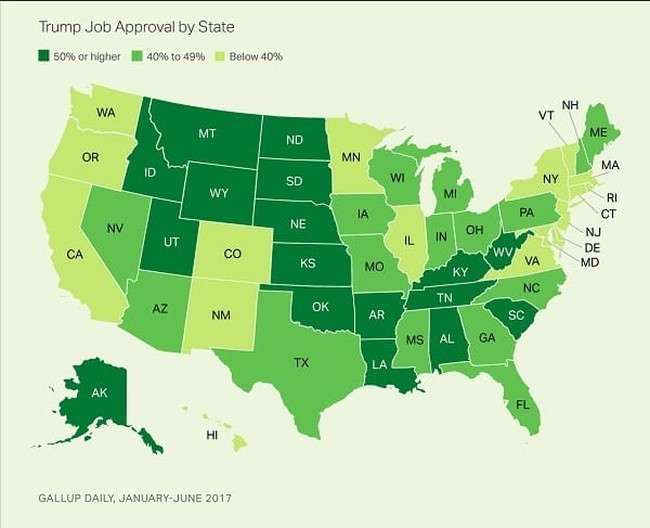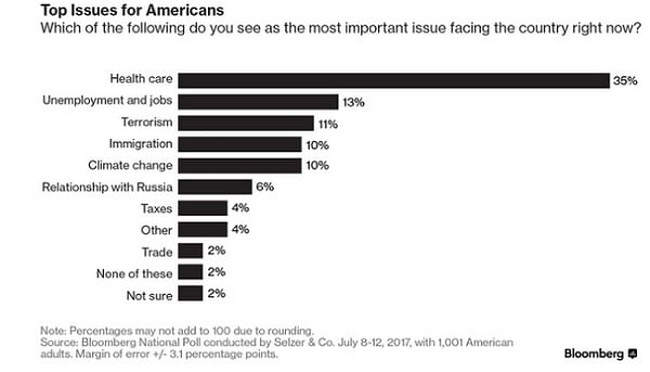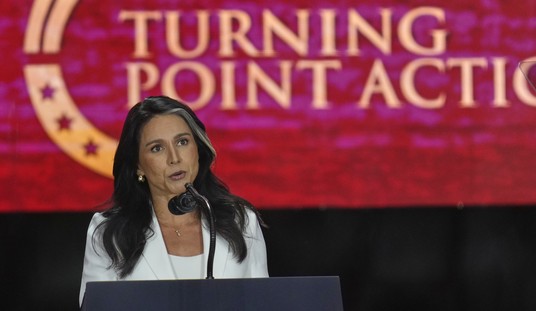With Donald Trump’s popularity rating floating around 40% a good slice of Democrats and a non-trivial number of anti-Trump conservatives have been approaching giddiness at the thought of the 2018 elections. Back in December, it seemed like the Democrats faced a possible Armageddon in the Senate where, with a tiny bit of bad luck, the Democrats looked like they could lose up to 9 Senate seats. Now they aren’t worried about big Senate losses and are beginning to talk about winning the House. But is that possible?
There are several interesting data points that indicate that Donald Trump’s approval rating may not be a huge factor in 2018.
The first flaw in the theory is that Trump is unpopular everywhere. That is the logic that had Hillary Clinton with an insurmountable lead in the 2016 polls and resulted in her winning a meaningless popular vote victory. Today Gallup reports that in 17 states President Trump has an approval rating well over 50%.

What this means is that Trump’s low national approval rating is of no help at all in one-third of the nation and, we can infer based on the special elections thus far, that it probably won’t help Democrats running in GOP congressional districts.
The second part of the equation is who will turn out in 2018. The Washington Post looked at the most recent Washington Post-ABC poll and wrote about it under the headline This poll should be a warning sign for Democrats.

The poll found that the respondents favored a Democrat Congress 52-38:
That first number would seem to be a big one: People prefer a Democratic Congress reining in Trump by a 14-point margin! That is a big margin. It’s actually similar in size to what it was for Republicans before their big wins in the 2010 and 2014 midterms. When the Post-ABC poll asked this question in April 2014, the GOP led on it by 14 points. When it was asked twice toward the end of the 2010 election, the GOP led by between eight and 16 points.
But then there’s 2002. That midterm election was close to a stalemate, but just over a month beforehand, a similar question rendered a 19-point advantage to Democrats — quite similar to today’s 14-point edge. Despite this, Democrats would actually go on to lose some seats in the House and the Senate.
But when answers of those who had voted in 2014, the last off-year election, were considered that number dropped to a 9 point Democrat advantage. And the appeal of the Democrats was limited:
Poll: Most Americans think the Democratic Party stands only for opposing @POTUS. pic.twitter.com/q90geSy8Sj
— Fox News (@FoxNews) July 19, 2017
National Journal reports on a study that emphasizes the work the Democrats must accomplish to make gains in 2018:
The centrist Democratic think tank Third Way reliably supports socially liberal, fiscally sensible policies that are catnip to the cosmopolitan wing of the party—and as a result, the group often aggravates the party’s base of populist progressives.
But a new study of last year’s election results, provided exclusively to National Journal, underscores the idea that Democrats need to win back working-class Donald Trump voters before they chase moderate Republicans who defected to Hillary Clinton. The analysis comes as a sobering reminder that, despite the golden opportunity Democrats have to take back the House next year, they will still have to win in areas outside their cultural comfort zone.
…
The conclusion comes as a bit of a surprise, given that Democratic moderates have been assiduously targeting GOP-leaning suburbs as a prime opportunity for realignment in the age of Trump. To win back the House, the report argues, Democrats need to continue to make inroads in territory around booming metropolitan areas while also appealing to more culturally conservative Trump voters.The paper spotlights some more uncomfortable realities: There were twice as many voters (around 6 million) who defected from President Obama to Trump than there were who went from Mitt Romney to Clinton (about 3 million). The GOP defectors disproportionately hail from states that aren’t competitive in Senate and presidential races, while the newfound Trump supporters are concentrated in the Midwestern battlegrounds. So Clinton’s impressive gains in deep-blue California’s Orange County and ruby-red Texas’s Harris County are unlikely to make a dent in the two states’ overwhelming partisan advantages.
The political crosscurrents on the House map also played to Trump’s favor, albeit less dramatically: Twenty-one House districts went from backing Obama to supporting Trump, while 15 switched from Romney to Clinton. Most of those Clinton-district Republicans have strong individual brands at the congressional level. Republicans hold all 15 of the Romney-Clinton seats, all 15 representatives outperformed Trump in their districts last year, and 11 of them won by whopping double-digit margins. It’s unlikely that Republicans will be able to maintain those advantages in their first midterm with Trump, but many have won under difficult circumstances before.
By contrast, Republicans now hold 12 of the 21 Obama-Trump seats. These districts appear to be steadily heading away from their Democratic roots, giving Republicans more opportunities in the future. In fact, two of the Democrats holding Obama-Trump seats (Reps. Jacky Rosen of Nevada and Tim Walz of Minnesota) are running for higher office, giving House Republicans unexpected openings.
Both of these latter points go back to the Gallup survey. Yes, nationally Trump may be sucking swamp water in approval ratings, but that doesn’t really translate into anything other than congressional districts that voted against Trump voting against Trump even more intensely. To make inroads, the Democrats have to convince voters in those Obama districts that flipped to Trump that a Democrat congressman provides better representation. What are the odds of that happening? I don’t believe in the predictive value of polls but there are two data points to consider:

And this via Mediaite and a post headlined WaPo Reporter Suggests Trump Voters Too Stupid To Understand Russia Probe:
After that, Jackson asked Parker, if reporters should stop reporting on the Russia meeting.
Certainly not she said before lamenting that Trump’s simpleton voters might just not be up to understanding the complexities of the scandal.
“No, the reporters report on news and are going to continue to uncover that, but I do think it is worth remembering in the beltway…what doesn’t matter to voters. And in a way it’s understandable that Russia is not the most trenchant issue, it’s not related to their day to day lives, if they can drop their kids at daycare, if they can put food on the table, and it’s very complicated. These names are incredibly hard to pronounce, there’s lots of confusing connections, there’s now eight people, they dripped out one by one, I mean there is not an easy narrative to take stock of.”













Join the conversation as a VIP Member